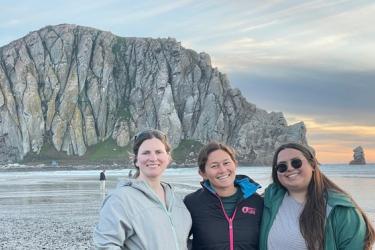Designing and curating the Newport Hydrographic Line (NH Line) exhibit at the Hatfield Marine Science Center (HMSC) Visitor Center has called for working with many people from different backgrounds. Nancy Steinberg was instrumental in this process, as her NH Line Storymap informed most of the written content on the banner. I have also been working closely with Renee Fowler from the HMSC Visitor Center who has been the expert on how to create an exhibit and has connected me to contacts. Scott Smith, a volunteer at the HMSC Visitor Center, has been working with me to repurpose an old touch table that will be an interactive display of the sampling and patterns observed along the NH Line. His technological expertise has helped troubleshoot a lot of the issues we faced when working with an old display that hadn’t been updated in many years.
This project has taught me that communicating with scientists is a crucial part of the process. There are many individuals who are responsible for the NH Line’s rich history and it’s important to make sure they are represented. Working with scientists who monitor the Newport Hydrographic Line, namely Anna Bolm (OSU-CIMERS), Jennifer Fisher (NOAA-NWFSC), and Kym Jacobson (NOAA-NWFSC), has been the most collaborative part about this project and instrumental to making sure the research is represented correctly. In science communication, it’s necessary to defer to the scientists who are the experts in their field on the key messaging of a project.
There are many costs associated with creating an exhibit that have generated collaboration in funding. When it comes to hosting the website that the touchtable will display, we have received funding from Oregon Sea Grant. NOAA is funding the printing of the banner. The HMSC Visitor Center will cover any technology costs involved with repurposing the touch table. I grew more comfortable with discussing funding and costs as I became more involved in the exhibit making process.
As a future science communicator, this project is preparing me with the necessary skills I need to work with many people from different backgrounds. This exhibit is made possible through the collaboration of experts in their field who are interested in sharing the research they conduct along the NH Line with the public. It also wouldn’t be possible without Oregon Sea Grant, who provided us with the space and expertise for the exhibit. As I work towards the final weeks of my fellowship, I hope you’ll continue to stay updated on the exhibit process.
Stay tuned for more updates next week!

